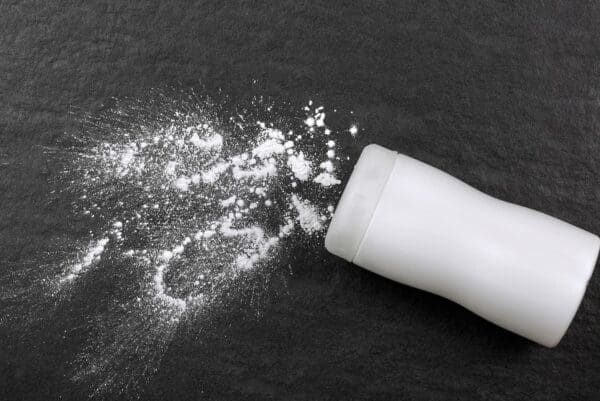
A woman came down with mesothelioma but she could not recall any obvious source for exposure to asbestos. Neither she nor any family member worked in a shipyard. No asbestos insulation was reported in her house. The roads did not contain any gravel containing asbestos fibers.
One possibility was that she had used a type of talcum powder as long as she could remember.
Woman’s Lung Tissue Contained Asbestos Fibers
Gordon et al 20141 recently analyzed the type of fibers in 50 samples of her brand of talcum powder. The age of the samples ranged from 50 years ago to those purchased within several years at several retailers.1
Gordon et al1 tested whether the talcum powder used by the woman with mesothelioma contained asbestos fibers. Yes, the samples did contain asbestos fibers.
Three laboratories checked the
- characteristics of the asbestos fibers,
- chances of inhaling asbestos fibers during talc application, and
- fibers in the woman’s lung tissues.
Laboratory A studied the shape, size, and type of the fibers in the talcum powder samples and compared them to asbestos fibers shown to cause mesothelioma.
All 50 Samples of Specific Talcum Powder Contained Asbestos
Gordon et al1 examined the type, size, and shape of the asbestos fibers in the 50 talcum powder samples sold over the years. Viewing each sample through transmission electron microscope, they inspected how the fibers dispersed and absorbed energy (energy-dispersive spectrometer), and scattered the electrons (selected area electron diffraction). These tests are analogous to using a prism to break visible light into the rainbow. These tests help identify the type of fibers.
To ensure accuracy, they looked at 100 views on each of five grids for each of the 50 different aged samples of the talcum powder.
They only counted fibers longer than 5 microns because these fibers can persist in the body. For reference, a human hair is 10 to 20 times wider than 5 microns.
The type of asbestos fibers in 4 of 5 samples was anthophyllite. One of 12 samples contained only tremolite asbestos (8%). Some samples contained two types of asbestos (8%) or three types (4%).
Forty of the fifty talc samples contained 10,000 asbestos fibers per gram of talcum powder. Six of the samples contained 250,000 asbestos fibers per gram of talcum powder. The asbestos fibers comprised up to 40% of the total fibers in the talcum powder samples!
The talcum powder samples contained asbestos fibers with the shape and size that can cause mesothelioma. Up until this report, anthophyllite asbestos fibers were not thought to cause mesothelioma.
Released Asbestos Fibers Floated to Nose Level
Laboratory B used filters to detect any floating asbestos fibers during the talcum powder dusting of the underarms. After application of the volunteers, the filters on their nose and mouth caught asbestos fibers of anthophyllite and tremolite types.
The lung tissue from the woman with mesothelioma contained asbestos fibers of both the anthophyllite and tremolite types. These fiber types were both present in the brand of talcum powder she used.
This Brand of Talcum Powder was Known to Contain Asbestos
In the 1976, Rohl and Langer found that 10 brands of talcum containing products—baby powder, talcum powder, facial powder contained not only talcum powder but also asbestos fibers.2 In comparison, 10 distinct brands did not contain any asbestos fibers.
Gordon et al stated, “The product with the highest asbestos content [in the Rohl and Langer study] was the same product tested in this study.”
The asbestos contamination comes from the mines for talcum. However manufacturers can source the talcum from a different mine that does not contain asbestos.2 40 years later, and this brand had not changed its source of talcum powder nor its asbestos content.
This report suggests that chronic exposure to anthophyllite asbestos fibers can lead to mesothelioma and death.
Unfortunately, neither scientific article provided the brand names of the analyzed talcum powders.




